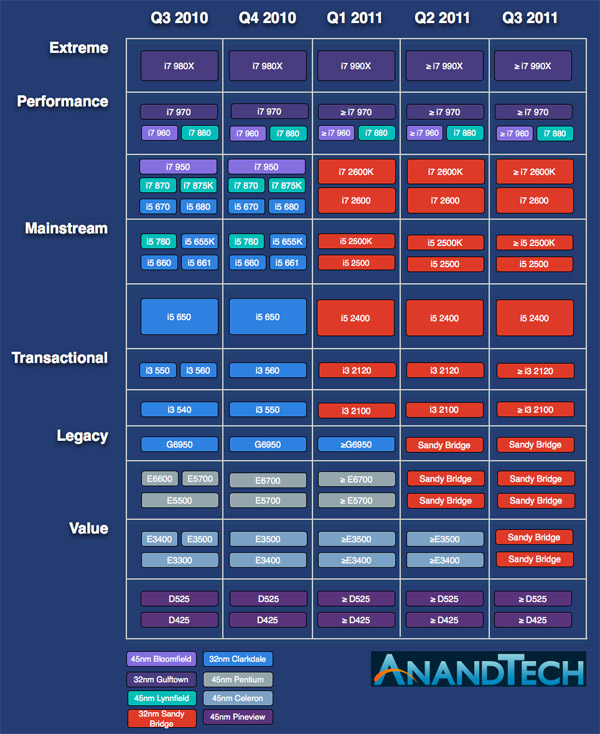The Sandy Bridge Preview
by Anand Lal Shimpi on August 27, 2010 2:38 PM ESTThe Roadmap & Pricing
I’ve defined the launch parts earlier in this article, but now I’m going to put them in perspective. When Intel provides its partners with roadmaps it also provides them with an idea of where future CPUs slot into various segments/price points. For example, Intel’s LGA-1366 roadmap tell us that in the “Extreme” market segment Intel only has a single product offering: the Core i7 980X. And in Q1 2011 the 980X gets replaced by the 990X.
Usually based on this information you can get a general idea of how much future products will cost - or at least what they will be comparable to. In this example the 990X will most likely be priced at whatever the 980X is priced at. Products may change, but the price people are willing to pay in a certain market segment usually doesn’t.
What we have below is the Intel roadmap, with Sandy Bridge included, for Q3 2010 through Q3 2011. The further out you go in a roadmap the lower your accuracy becomes, so I wouldn’t worry too much about us not seeing LGA-2011 on there yet.
It’s based on this roadmap that I mentioned some pricing earlier. If all stays the same, the Core i7 2600K will take the place of the Core i7 950, currently priced at $562. The 2600 will fit somewhere around the 680 and 875K ($342) and the 2500K will replace the i5 760/655K ($205 - $216).
The cheapest Sandy Bridge at launch will be the Core i3 2100, which will replace the i3 560 at around $138.
Now pricing is always a huge variable, but I have to say, based on the performance you’re about to see - these parts would be priced right.











200 Comments
View All Comments
Touche - Friday, August 27, 2010 - link
And the naming...OMG!There will be i7 processors that require three (3 !!!) different sockets! Maybe even 4 when 2011 comes. Intel can't get their naming right for quite some time now, but they've outdone themselves this time.
ereavis - Monday, August 30, 2010 - link
Processor names really should mean something, even if AMD and Intel don't agree. It's annoying that I have to wikipedia a processor (or memorize a thousand processors) to know what it is. We are still getting quotes for three year old Opterons and Xeons (that we're using as desktops no less), those only add to the annoyance.What ends up happening - good for Intel bad for technology advancement - is non IT type people buying computers are buying DDR2-667 based three-year old desktop processors.
BSMonitor - Friday, August 27, 2010 - link
Ummm, but Bulldozer comes with AM3-r2... Just a sketchier way of saying new MB needed.At least this new Intel isn't trying to BS you. Significant revisions to the architecture require different pin layouts/counts... It is inevitable with processor evolution.
Touche - Friday, August 27, 2010 - link
Actually, it should be AM3 compatible:http://www.tomshardware.com/reviews/bulldozer-bobc...
Even if it's not, AM2/AM3 lasted quite some time.
"At least this new Intel isn't trying to BS you. Significant revisions to the architecture require different pin layouts/counts... It is inevitable with processor evolution."
They know in advance what they need and could design a socket to support multiple processors. And i7/i5/i3 definitely don't need different ones.
BSMonitor - Friday, August 27, 2010 - link
"Even if it's not, AM2/AM3 lasted quite some time."Not all AM2 processors were compatible with AM2+ MB or vice versa, not all AM3 processors compatible on AM2+ MB.
It's still 3 different sockets.
Marketing buddy, marketing.
By the time 1366 is replaced, it will have been on the market for 4 years.
stmok - Saturday, August 28, 2010 - link
Eh, no its not. Bulldozer does NOT work with non-AM3+ mobosAMD engineers made a decision not to make it backward compatible for three reasons.
(1) No one but enthusiasts upgrade their CPUs. People in the real world upgrade their whole computer.
(2) Bulldozer introduces new features that won't work with existing Socket AM3 mobos. (Isn't it bloody obvious when they have to introduce a new socket specification?)
(3) It would cost more money and delays if they were to make a backward compatible version of Bulldozer.
As a result, they made a compromise:
You can take your existing AM3 CPU to AM3+ mobos, while you wait for Bulldozer to arrive. BUT, you can NOT upgrade your existing AM3 based system to Bulldozer.
Simply put...
AM3+ CPU and AM3+ mobo = OK
AM3 CPU and AM3+ mobo = OK
AM3+ CPU and AM3 mobo = Sorry. No.
So it doesn't matter if AMD "Bulldozer" or Intel "Sandy Bridge". You will need a new mobo.
Ard - Friday, August 27, 2010 - link
AMD seriously has their work cut out for them with Bulldozer. The lowest end Sandy Bridge processor absolutely trounced the competition. It's insane what Intel is pulling off here, especially in the integrated graphics arena. Really makes me hope Larrabee comes back as a discrete product in the next few years.dgz - Saturday, August 28, 2010 - link
poor kid, you don't realize 2400 is not nearly lowest end.Finally - Sunday, August 29, 2010 - link
Doesn't that make him a "(filthy) rich kid"?Quodlibet - Friday, August 27, 2010 - link
- based on the shown roadmap, the replacement for the i5 760 is actually the i5 2500(K).- i7 will have even better performance with 8 MB L3 Cache and higher graphics turbo. So there is even more performance potential in the SandyBridge die that Intel could unlock for lower SKUs if needed.